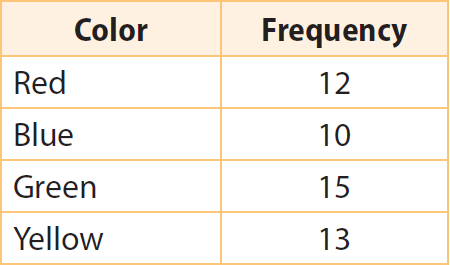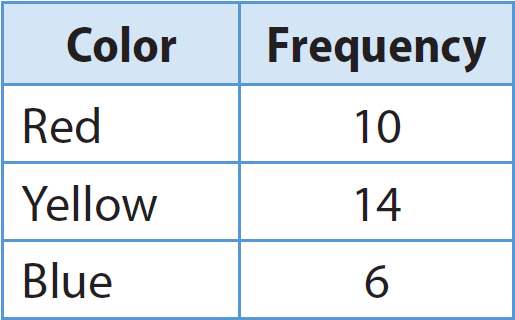CALCULATING EXPERIMENTAL PROBABILITY WORKSHEET
Problem 1 :
Martin has a bag of marbles. He removed one marble at random, recorded the color and then placed it back in the bag. He repeated this process several times and recorded his results in the table. Find the experimental probability of drawing each color.

Problem 2 :
A spinner has three unequal sections : red, yellow, and blue. The table shows the results of Nolan’s spins. Find the experimental probability of landing on each color.

Problem 3 :
A dentist has 400 male and female patients that range in ages from 10 years old to 50 years old and up as shown in the table. What is the experimental probability that the next patient will be female and in the age range 22–39 ?

Problem 4 :
David tossed a coin 20 times and received head 12 times and tail 8 times. Find the experimental probability of getting tail.
Problem 5 :
A six faced cube numbered from 1 to 6 is rolled 5 times and 3 is received twice and 5 is received thrice. Find the experimental probability of getting the number 3.

Detailed Answer Key
Problem 1 :
Martin has a bag of marbles. He removed one marble at random, recorded the color and then placed it back in the bag. He repeated this process several times and recorded his results in the table. Find the experimental probability of drawing each color.

Solution :
Step 1 :
Find the total no. of trials.
Total number of trials = 12 + 10 + 15 + 13 = 50
Step 2 :
Find probability for each color.
Red :
Frequency / Total no. of trials = 12/50 = 6/25
Blue :
Frequency / Total no. of trials = 10/50 = 1/5
Green :
Frequency / Total no. of trials = 15/50 = 3/10
Yellow :
Frequency / Total no. of trials = 13/50
Problem 2 :
A spinner has three unequal sections: red, yellow, and blue. The table shows the results of Nolan’s spins. Find the experimental probability of landing on each color.

Solution :
Step 1 :
Find the total no. of trials.
Total number of trials = 10 + 14 + 6 = 30
Step 2 :
Find probability for each color.
Red :
Frequency / Total no. of trials = 10/30 = 1/3
Yellow :
Frequency / Total no. of trials = 14/30 = 7/15
Blue :
Frequency / Total no. of trials = 6/30 = 1/5
Problem 3 :
A dentist has 400 male and female patients that range in ages from 10 years old to 50 years old and up as shown in the table. What is the experimental probability that the next patient will be female and in the age range 22–39 ?

Solution :
Step 1 :
Find the total no. of patients.
Total no. of patients is
= 44 + 66 + 32 + 53 + 36 + 50 + 45 + 74
= 400
Step 2 :
Find the no. of female patients in the age range 22 - 39.
No. of female patients in the age range 22 - 39 = 50
Step 3 :
Find the probability.

Experimental probability = 50/400
Simplify.
Experimental probability = 1/8
Problem 4 :
David tossed a coin 20 times and received head 12 times and tail 8 times. Find the experimental probability of getting tail.
Solution :
Step 1 :
Find the total no. of trials.
Total number of trials = 20
Step 2 :
Find the no. of times tail received.
Number of times tail received = 8
Step 3 :
Find the probability.

Experimental probability = 8/20
Simplify.
Experimental probability = 2/5
Problem 5 :
A six faced cube numbered from 1 to 6 is rolled 5 times and 3 is received twice and 5 is received thrice. Find the experimental probability of getting the number 3.
Solution :
Step 1 :
Find the total no. of trials.
Total number of trials = 5
Step 2 :
Find the no. of times 3 received.
Number of times 3 received = 2
Step 3 :
Find the probability.

Experimental probability = 2/5
Kindly mail your feedback to v4formath@gmail.com
We always appreciate your feedback.
©All rights reserved. onlinemath4all.com
Recent Articles
-
Digital SAT Math Problems and Solutions (Part - 150)
Apr 25, 25 11:46 AM
Digital SAT Math Problems and Solutions (Part - 150) -
AP Calculus AB Problems with Solutions (Part - 19)
Apr 24, 25 11:10 PM
AP Calculus AB Problems with Solutions (Part - 19) -
AP Calculus AB Problems with Solutions (Part - 18)
Apr 24, 25 11:06 PM
AP Calculus AB Problems with Solutions (Part - 18)
